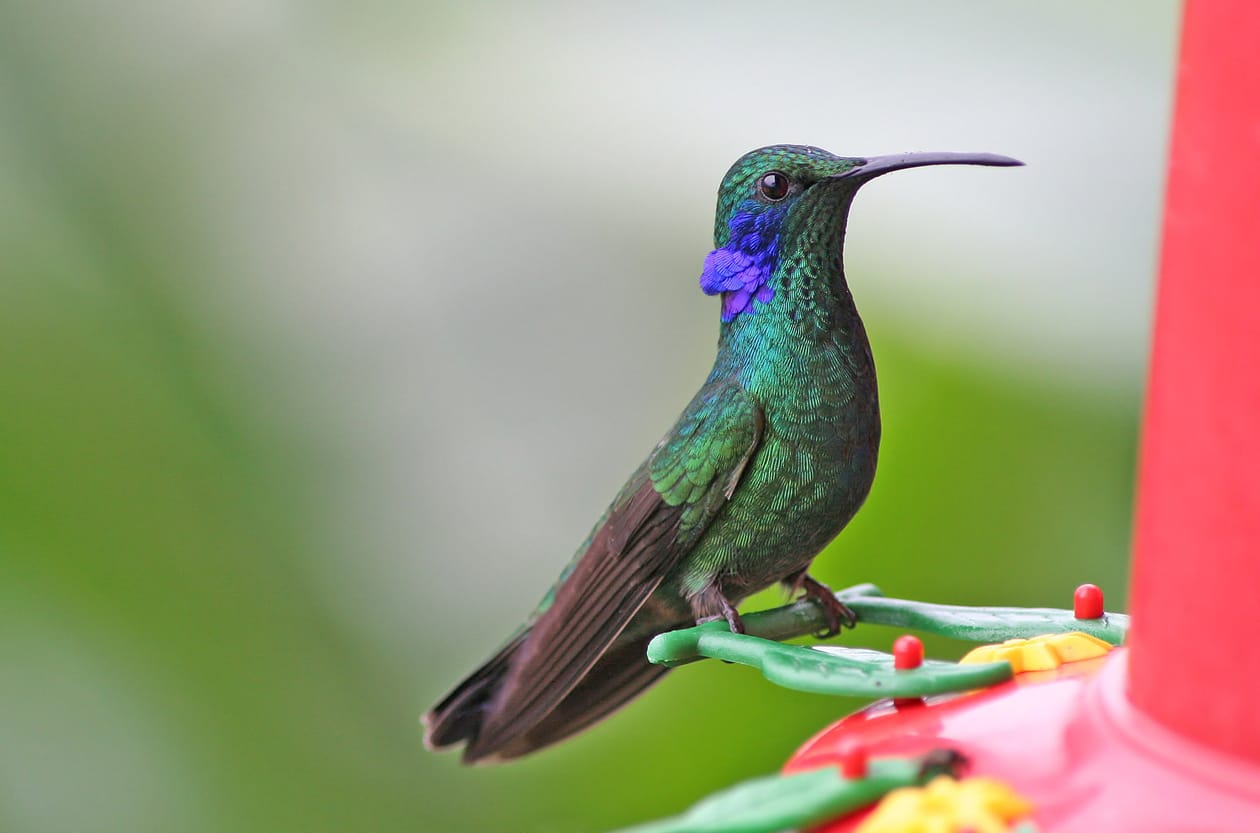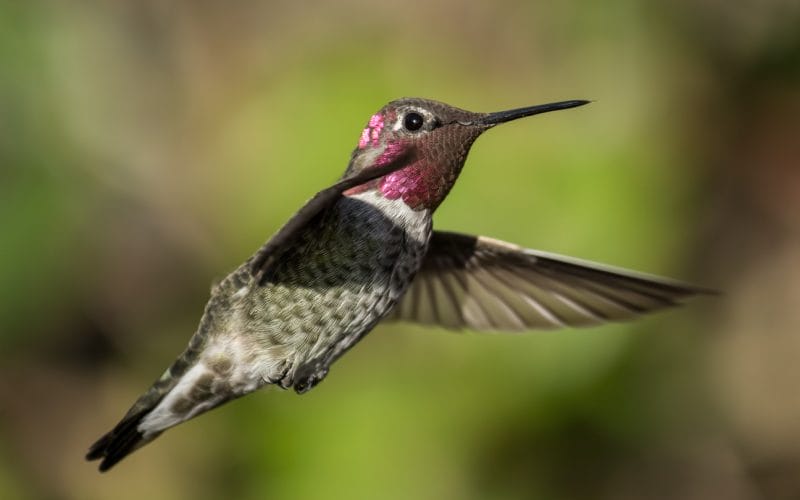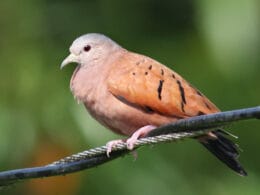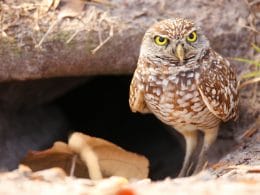Hummingbirds are fast-moving, tiny birds that feed on nectar and insects. They belong to the Trochilidae family, which includes roughly 360 species worldwide.
Nearly 30 different species of hummingbirds have been spotted in the United States. In Ohio, there are two primary species of hummingbird. However, state bird records acknowledge a total of seven species.
In this article, we’ll take a closer look at the hummingbirds in Ohio that we can find and observe.
Common Hummingbirds in Ohio
In Ohio, we have discovered two species of hummingbirds that are either common or semi-common. However, no hummingbird species are considered residents.
Ruby-throated and Rufous Hummingbirds are considered seasonal hummingbird species in Ohio. They are the most common species that you can spot in your backyard.
1. Ruby-throated Hummingbird
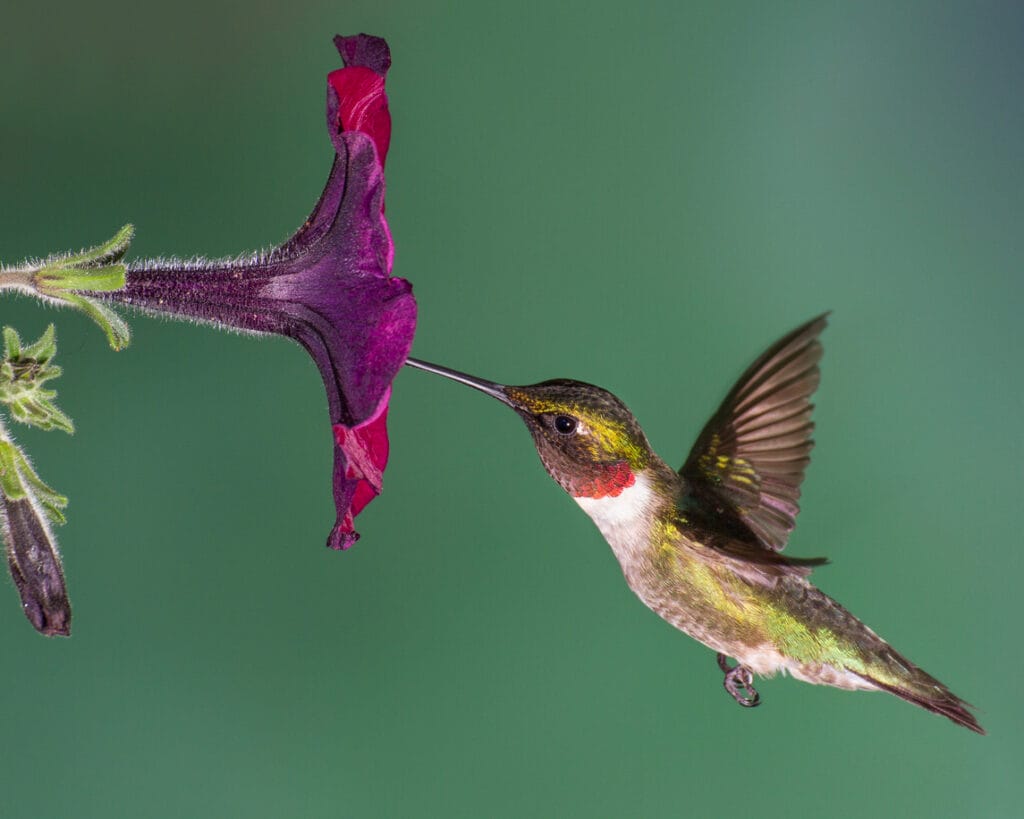
- Scientific name: Archilochus colubris
- Length: 2.8-3.5 inches
- Weight: 0.1-0.2 oz
- Wingspan: 3.1-4.3 inches
The Ruby-throated Hummingbird’s scientific name is Archilochus Colubris. Throughout Ohio, Ruby-throated Hummingbirds are a common sight around the summer. They normally arrive in April, but largely, they arrive in May.
In the eastern portion of the United States, ruby-throated hummingbirds are the most frequent hummingbird. They begin their fall migration between September and Mid-October, however, some stay longer.
The Ruby-throated Hummingbirds’ lengths vary from 2.8 to 3.5 inches. They weigh from 0.1 to 0.2 ounces, and their wingspan ranges from 3.1 to 4.3 inches.
These tiny birds fly from one nectar source to another, catching insects in mid-flight or from spider webs. They come to a halt on a small twig now and then, but their legs are so short that they can only shuffle along a perch.
These hummingbirds mostly feast on nectar, especially that of orange and red tubular plants like honeysuckle. They’re most commonly seen in open places such as meadows and orchards and are rarely bothered by the presence of humans.
Ruby-throated Hummingbirds migrate to Mexico, Central America, and the Caribbean islands in the winter. This is a journey that involves flying across the Gulf of Mexico in a single 20-hour flight.
Male Ruby-throated Hummingbirds
The male Ruby-throated Hummingbirds have a red ruby throat that sometimes looks black in certain lighting. They also have a vivid green back and crown with a gray-white underbelly.
Male Ruby-throated Hummingbirds, in their defense of flowers and feeders, can be very aggressive. They don’t stay around long after mating, and by early August, they may have migrated already.
These hummingbird species interact with each other by making quick squeaky chirps. However, males are only communicative courtship. They also get squeaky when defending their territory.
The males normally arrive in Ohio before the females by one or two weeks to stake out their feeding territories.
Female Ruby-throated Hummingbirds
Female Ruby-throated Hummingbirds have brownish crowns and sides. They’re green on the back with a white underside.
Ruby-throated females raise their young alone in nests consisting of thistle or dandelion tied together with spider silk on thin twigs. They lay from 1 to 3 tiny eggs that are only 0.6 inches in diameter.
2. Rufous Hummingbird
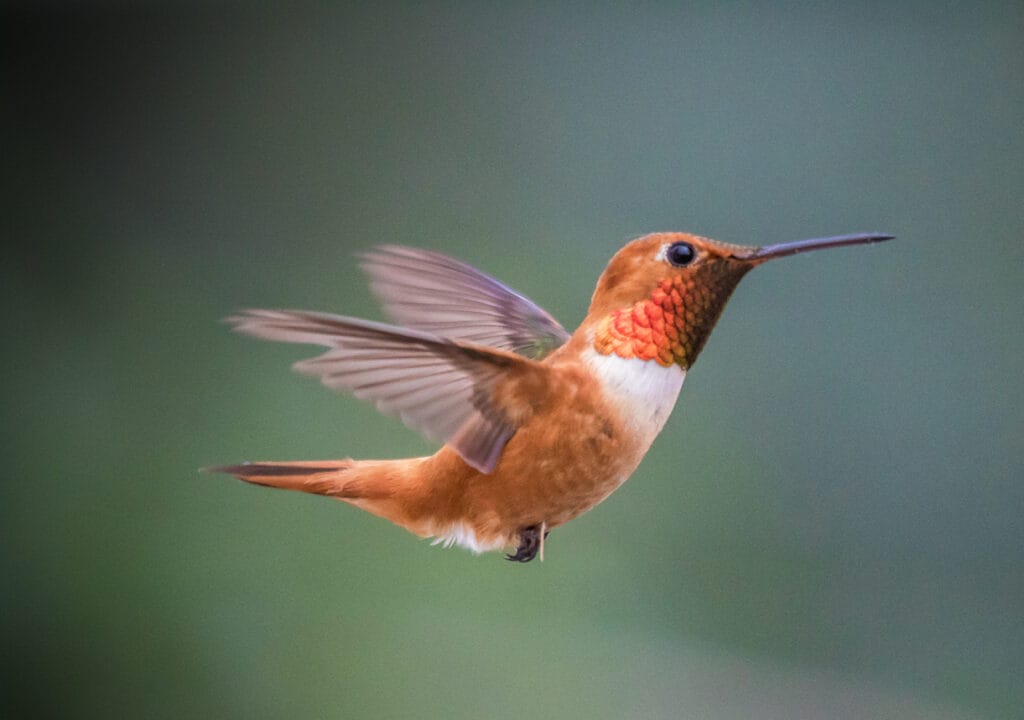
- Scientific name: Selasphorus rufus
- Length: 2.8-3.5 inches
- Weight: 0.1-0.2 oz
- Wingspan: 4.3 inches
Rufous Hummingbirds, or Selasphorus Rufus, are known for being a feisty species. They get a little aggressive when they have to share feeders or when they’re chasing away other hummingbirds.
They’re not as common as Ruby-throated Hummingbirds in Ohio. However, a few of them visit north almost every year in early May. Therefore, try to keep your hummingbird feeders out then.
It is the most common hummingbird in North America and Canada. It can also out-fly all other hummingbird species and is the hummingbird with the best maneuverability.
While the rufous hummingbird is a western hummingbird, it is perhaps the second most regularly seen species in the east, behind the ruby-throated hummingbird.
Rufous Hummingbirds’ length ranges from 2.8 to 3.5 inches. They weigh from 0.1 to 0.2 ounces, and their wingspan is 4.3 inches long.
Hummingbirds of this species are extremely thin and tiny, with straight beaks and short wings that don’t extend to the tail’s ends when perched.
These hummingbirds use their wings to catch and eat insects. The nectar from flowers is their primary source of nutrition. They feed frequently during the day because of their small size and fast metabolism.
They go into a dormant state at night to save energy. They’re prey for predators that eat insects and tiny birds.
Rufous Hummingbirds are one of the world’s longest-distance migrators, covering up to 4000 miles each way. In the spring, they migrate north along the Pacific Coast, then in the late summer and fall, they move north via the Rocky Mountains.
Male Rufous Hummingbirds
Males have an orange-red throat and a white patch on the upper breast. Male Rufous Hummingbirds, like the Ruby-throated Hummingbirds, are frequently the first to arrive in Ohio to stake out their feeding areas.
The males of this bird appear to be more aggressive than their female counterparts. During migration, they are hostile and chase away any other hummingbirds that emerge, including larger hummingbirds and resident hummingbirds.
Males will even pursue females away from food sources both during and outside of breeding seasons, fighting with both their own species and other hummingbird species.
By the end of September, the males have usually left Ohio, followed by the females and the young two weeks later.
Female Rufous Hummings
Females have a creamy belly and are greenish-brown on the back and rusty colored on the sides that distinguish them from the males.
They use soft plant and spider webs to hold their nest together up in the trees. They lay a clutch of 2 to 3 small white eggs, each measuring around 0.5 inches long.
Rare Hummingbirds in Ohio
When it comes to hummingbirds in Ohio, you can also spot other rare species. They’re not common in the state as they’ve only passed a few times and didn’t stay for long.
These species aren’t only rare, some of them only passed by Ohio by accident.
3. Calliope Hummingbird

- Scientific name: Selasphorus calliope
- Length: 3.1-3.5 inches
- Weight: 0.1 oz
- Wingspan: 4.1-4.3 inches
Calliope Hummingbird is considered an accidental species to Ohio as it has only visited a few times and is not on a certain schedule. Its scientific name is Selasphorus Calliope.
Calliope Hummingbirds’ lengths vary from 3.1 to 3.5 inches, their weight is usually 0.1 ounces, and their wingspan ranges from 4.1 to 4.3 inches.
The Calliope Hummingbird, which is about the size of a ping-pong ball, is the tiniest bird in the United States, but it manages to fly more than 5000 miles each year, from Mexico to Canada and back.
The spring migration of Calliope Hummingbirds takes them to the Rocky Mountains along the Pacific Coast, where they reproduce in California, Colorado, and up to the northwest states of Alberta, British Columbia, and Vancouver Island.
They usually begin their migration in February and arrive as far north as Canada between mid-April and early May.
Despite their small size, Calliope Hummingbirds are fiercely protective of their territory. They won’t hesitate to attack much larger birds to protect their territory, even birds as large as Red-tailed hawks when they’re nesting.
Male Calliope Hummingbirds
Male Calliope Hummingbirds possess gorgets that are vivid magenta in color, shiny green backs and sides. They also have a dark tail.
The male of these hummingbirds performs a unique courtship show in which he flaps his wings at a frequency that sounds like a buzzing bee. Flapping different feathers sends different messages to a female in order to attract and appeal to her.
Males of this species are aggressive and spend much of their time watching their territory from a high perch.
Female Calliope Hummingbirds
Females don’t have the iridescent throats that males do, and their underbelly is pinkish-white rather than white. They normally make their nests on evergreen trees, and they may reuse or build on top of an old one.
4. Allen’s Hummingbird
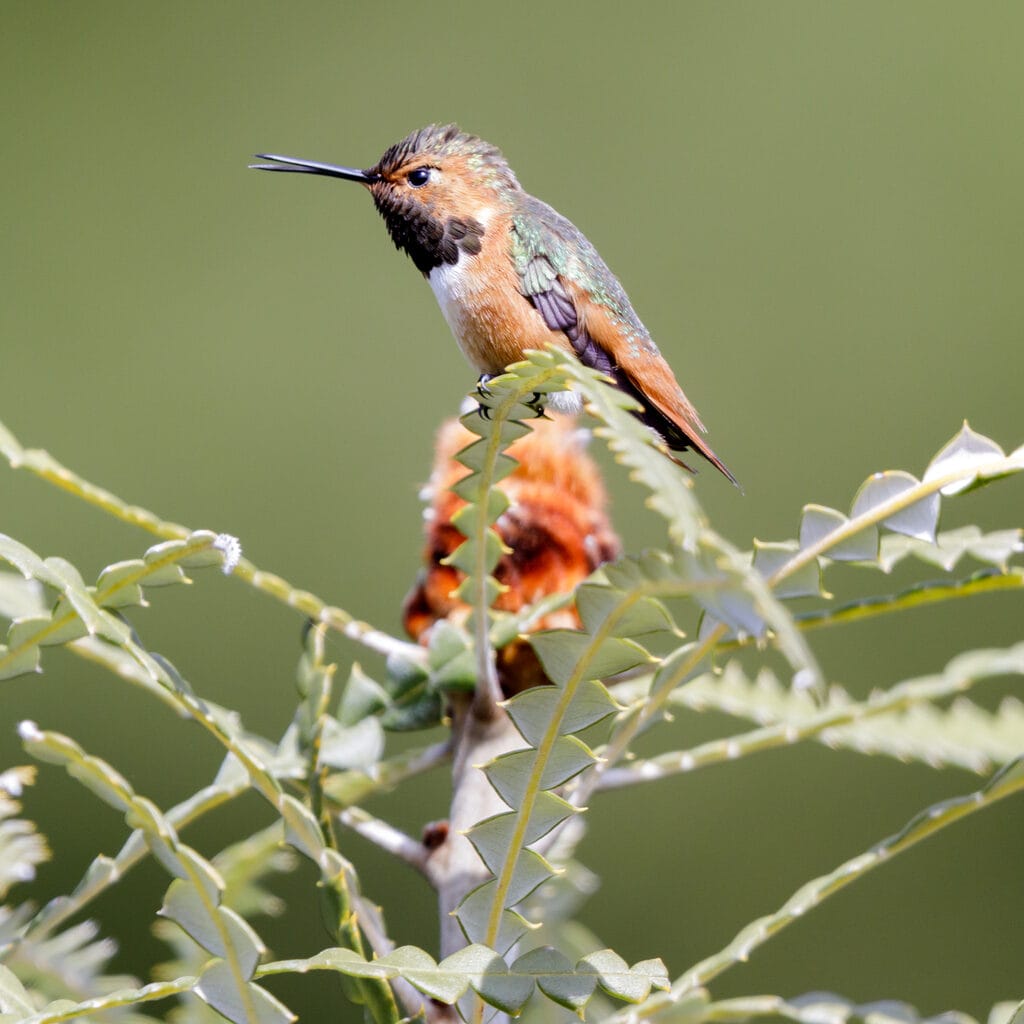
- Scientific name: Selasphorus sasin
- Length: 3.5 inches
- Weight: 0.1-0.14 oz
- Wingspan: 4.3 inches
Allen’s Hummingbirds are rare hummingbirds in Ohio, with only a few sightings in the winter and no records in the last ten years. Allen’s Hummingbirds’ scientific name is Selasphorus Sasin.
They’re 3.5 inches, 0.1 ounces in weight, and their wingspan is 4.3 inches.
Allen’s Hummingbirds are difficult to distinguish from Rufous Hummingbirds in the small region of coastal forest and scrub that runs between California and Oregon.
Allen’s Hummingbirds have bright reddish-orange throats, orange bellies, tails, and eye patches on males. Males and females both have long, straight bills and coppery green backs, but females lack the bright throat color.
This species of hummingbirds flutters from one flower to the next, ticking as it eats nectar. It’s also known to catch insects in the air.
Allen’s and Rufous Hummingbirds vary in that Allen’s have narrower outer tail feathers than Rufous. They have up to three broods every year and build nests at no fixed height along shaded streams.
Allen’s Hummingbirds spend the winter in Mexico. They then migrate up the Pacific Coast of California and Oregon as early as January. Though, they are most common between March and July.
5. Anna’s Hummingbird
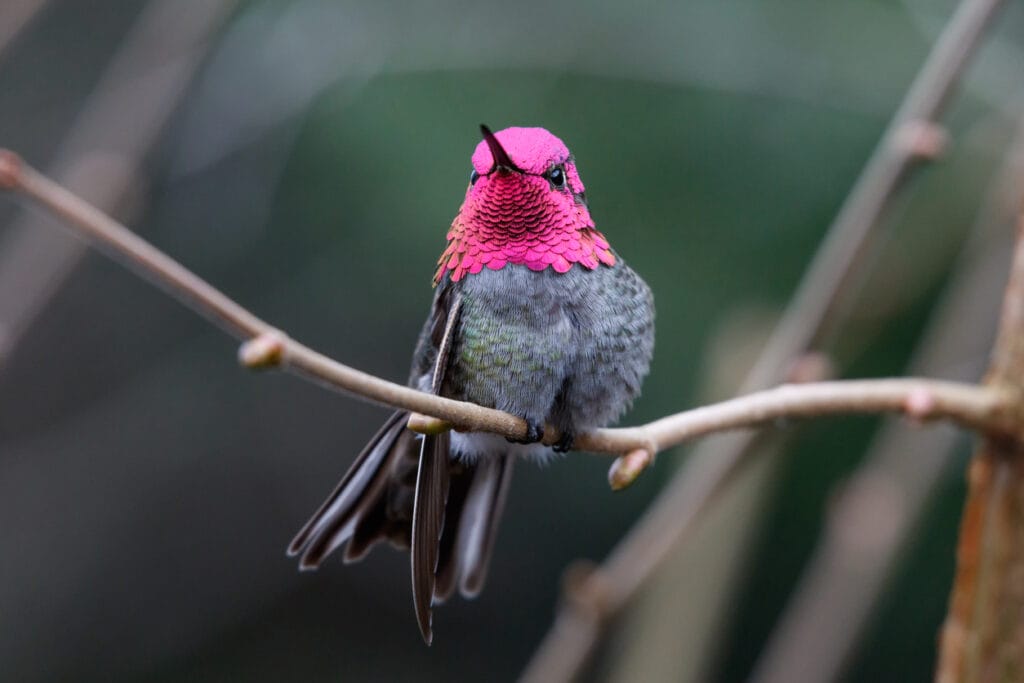
- Scientific name: Calypte anna
- Length: 3.9-4.3 inches
- Weight: 0.1-0.2 oz
- Wingspan: 4.7 inches
Anna’s Hummingbirds are little birds with a green and grey color scheme. The female’s throat is greyish with traces of red spotting, while the male’s head and throat are iridescent reddish-pink.
The green of their feathers is a little brighter and iridescent than most other birds. Their bill is long, slender, and straight. Additionally, they eat nectar with their tongues.
They’re 3.9 inches, from 0.1 to 0.2 ounces, and their wingspan is 4.7 inches. Along the Pacific Coast, they are the most frequent hummingbird. Their scientific name is Calypte Anna. These creatures are medium-sized with broader tails that are linked to their stocky bodies.
Anna’s Hummingbirds are unusual in that they do not migrate, but some migrate small distances in the winter. Anna’s hummingbirds can be found in a variety of habitats, including backyards and parks with huge colorful blooms and nectar feeders, as well as scrub and savannah.
During courting, the males climb up to 130 feet in the air before falling back to the earth with a burst of noise from their tail feathers.
They’re well-known for their aggressive behavior when defending territories. Anna’s males are louder than males from other hummingbird families. As they feed or mark territories, males make a succession of complex scratchy noises.
They’re also known for their powerful vocals, which fascinate audiences with a metallic, buzzy song.
Anna’s Hummingbirds build their nests in trees between 6 and 20 feet high, and they usually have two to three broods every year.
Outside of their breeding seasons, they have been sighted in Ohio. Most sightings of this bird have been in the state’s central-eastern regions.
6. Mexican Violetear

- Scientific name: Colibri thalassinus
- Length: 3.8 – 4.7 in
- Weight: 0.17 – 0.20 oz
- Wingspan: 5 – 6 in
Mexican Violetears is a rare and accidental species in Ohio. Non-breeding Mexican Violetears are more likely to travel north into the United States to Texas, but they have been recorded as far north as Michigan and Ohio on rare occasions.
Mexican Violetears are medium-sized hummingbirds with violet patches on the sides of their heads and breasts and are metallic green. Males and females are nearly identical, with the exception that males are slightly larger and brighter.
Their lengths vary from 3.8 to 4.7 inches and their weights range between 0.17 and 0.2 ounces.
Mexican Violetears breed in the forests of Mexico, Central America, and Nicaragua, although they can also be found in the Bolivian and Venezuelan mountains.
Despite the fact that these small beautiful creatures excel at hiding while feasting on nectar, their chirpy calling makes it easy to find them. Since every day, males sing frequently throughout their territory.
Nectar and insects are their primary sources of nutrition. A Mexican Violetear forages alone most of the time, but you can find several of them in deforested regions with flowering trees.
Conclusion
If you’re an Ohio resident, then your chance at seeing a hummingbird in your backyard is relatively high. Whichever your favorite species is, wait for their immigration period and test your luck then.
We hope you enjoyed our guide on the most common hummingbirds in Ohio.
FAQ
The Ruby-throated and Rufous Hummingbirds are the most common in Ohio.
Try putting out feeders in your garden. That is your best chance of seeing them. Plus, you can put your feet up and have a coffee while you wait!
To find out where recent sightings of hummingbirds have been, try eBird. You can search for the latest sightings or particular species or what has been seen in a certain area.




